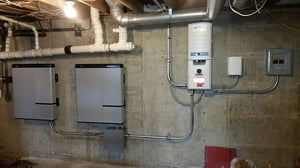You heard the alerts all day. Severe weather is predicted in your area for this evening. You keep an eye on the dark clouds as they creep closer. Finally, the sky overhead turns black, the wind starts howling, and the rain comes down in sheets.
This isn’t another run-of-the-mill storm.
Your lights begin to flicker, and then the electricity goes out altogether. You receive a pre-recorded message from your power company saying there are downed power lines, and you could be without electricity for some time.
Now is not the time to run around your house looking for that flashlight you got as a Christmas present four years ago. Now is the time to grab your emergency kit, gather your family in a safe spot, and wait out the storm.
Even with advanced technology and a deep understanding of meteorology, weather predictions may not always be accurate, or they may not always come early enough for you to properly prepare.
No matter what area of the country you live in, you’re not safe from unexpected outages or disaster situations. From earthquakes to severe storms, tornados, hurricanes, and blizzards, mother nature can strike anywhere. And man-made disasters can be even more unpredictable.
That’s why it’s essential to plan ahead and prepare for an unexpected power outage. In this blog, we’ll outline four steps that you can take to get your home ready.
How to Prepare Your Home for a Power Outage
1. Prepare an Emergency Kit
First things first, you should consider what are the most common natural disasters for your area and make a list of essential emergency items to handle the situation. Collect and store these items in an easily accessible place so they’re ready to go when you need them most.
This emergency kit should have several sources of light, like flashlights, batteries, candles, and a match or lighter. Another good thing to include in this kit is a battery-operated radio. It will be the easiest way to access vital news and weather updates throughout the disaster.
Don’t overlook things like first aid kits, medications, and personal hygiene products. You never know when these items could come in handy, and it will be much safer for you if everything is gathered together and can easily be transported to your safe room during the disaster.

Multi-tools, cash, and blankets are also good items to have in your stash. If possible, have backup battery banks that you can use to charge your cell phone or other small electronic devices.
Don’t forget any supplies your pets may need as well. From food to distracting toys to a leash, be sure you are able to make them feel comfortable and calm.
2. Have a Plan for Eating and Drinking
Some power outages last just a few minutes. Some can last days. Food may not be top-of-mind, but it is certainly a necessity to safely weather the storm or disaster.
You’ll want to have plenty of water to last you throughout the disaster. A good rule of thumb is to have about one gallon of fresh, bottled water per person per day. Staying hydrated will keep you alert and feeling your best.
In addition to water, you should also have a generous supply of food. Non-perishable food, like beans, canned meat or fish, and canned vegetables are a great place to start. These have long shelf lives and are quick and easy to eat in an emergency situation.
It isn’t a bad idea to have something on hand that can heat these items up. You can buy Canned Heat, a small can that ignites a little flame. These are like what caterers use at events to keep food warm that’s on the buffet.
If you’re thinking of using other fuel sources like wood or propane, keep in mind you may not be able to go outside, and these fuel sources should not be burned inside.
Other options are cereals, boxed cookies, dried fruit, nuts, and even some candy. A sweet treat could go a long way in making a scared child a little happier (or adult, for that matter!).
Additionally, you may want to grab a food thermometer. This can be used to check the internal temperature of the food in your fridge and freezer to ensure that it is safe to eat.
3. Stay Together and Find Ways to Have Fun
In our busy lives, it can be hard to find time to unplug and enjoy quality time with our loved ones. Even popular leisure activities like watching TV and browsing the web often involve more staring at screens and less interacting with one another.
A power outage can be a turbulent and stressful time, especially if it’s caused by dangerous weather or an emergency situation. But it doesn’t mean you can’t entertain yourselves.

A power outage is a time we’re forced to detach from work and other distractions and enjoy time with the people we’re in this with. Staying together can keep moods high and stress low, allowing you to handle the situation better.
It will also make sharing limited resources easier, and you can more quickly react as a group or evacuate if necessary should the situation take a turn for the worse.
As part of your emergency preparedness kit, pull together some things to entertain you and your party. These could be things like a deck of cards, board games, books (who doesn’t love a few rounds of Mad Libs?), or magazines. You can also play games like charades or headbands to really get people interacting and keep spirits high (just be careful moving around too much if it’s dark).
For small children, a favorite stuffed animal can make them feel more secure. Coloring books and non-electronic toys can help keep them distracted from these scary times.
4. Get Backup Electricity
Just because the grid goes down and the electricity goes out doesn’t mean your home has to be without power entirely. Back-up generators and solar energy stored in batteries are two options that can keep your home up and running.
Back-up generators will be the cheaper option and can be purchased at a big-box or hardware store for a few hundred or a few thousand dollars. In addition, many generators can be easily transported to other locations. However, they are dependent on an outside fuel source, like natural gas or propane.
Fuel may be difficult to come by in a disaster situation as others stock up in order to power their generators. And generators often give off harmful fumes, so they’ll have to be located outside or in a well-ventilated area.
Another option is to install a solar storage system along with your solar energy system. Excess electricity generated by your solar system will be stored in your battery system. Then, when the grid goes down, your house will start drawing on this stored electricity.
 While this option will cost more than a generator, its fuel source is sunlight, which should be much easier to come by than gasses.
While this option will cost more than a generator, its fuel source is sunlight, which should be much easier to come by than gasses.
Keep in mind with both a generator and solar batteries, you probably won’t be able to fully power your entire home as you would if the electricity was back on. These options are meant to power a few necessary items, such as medical equipment, a few household appliances, space heaters, lights, or to charge electronics.
You’ll have to prioritize what electronic equipment is the most important to you in the event of a prolonged power outage, and find a generator or install a solar energy storage system that suits your needs.
Staying Safe When the Lights Go Out
A natural disaster or wide-spread accident can be an extremely stressful time for you and your family. This can be compounded when the electricity goes out, and we lose access to all the modern conveniences we’ve become so accustomed to.
Even if these events seem unlikely to you, it’s better to spend an hour preparing for a prolonged power outage than to be caught unprepared by an emergency situation.
Whether it’s grabbing a few flashlights and some canned food, or it’s looking into a backup power solution, you’ll thank yourself for spending the time now when the going gets tough.



